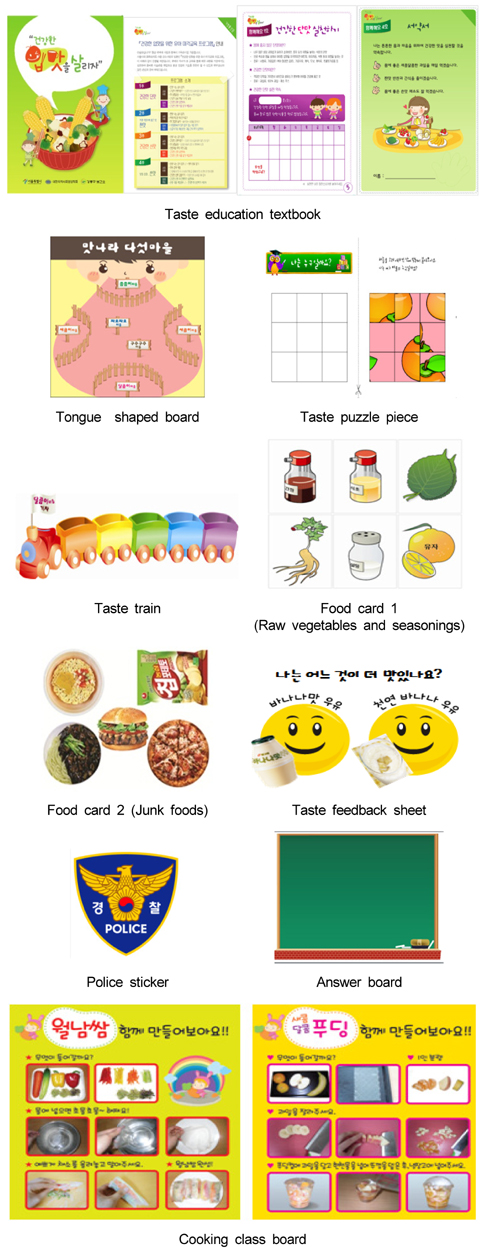Nutr Res Pract.
2012 Oct;6(5):466-473.
The development of a taste education program for preschoolers and evaluation of a program by parents and childcare personnel
- Affiliations
-
- 1Major in Food and Nutrition, Wonkwang University, Jeonbuk 570-749, Korea.
- 2R&D Planning Team, F&N health Co. LTD., Seoul 138-202, Korea.
- 3Health Promotion Division Seoul Metropolitan Government, Seoul 100-743, Korea.
- 4Department of Food Science and Nutrition, Daejin University, 11-1 Seondan-dong, Pocheon, Gyeonggi 487-711, Korea. kchoi@daejin.ac.kr
Abstract
- The change in people's dietary life has led to an increase in an intake of processed foods and food chemicals, raising awareness about taste education for preschoolers whose dietary habits start to grow. This study aims to evaluate the effectiveness and satisfaction of parents and childcare personnel after developing a taste education program and demonstrating it in class. A part of the curriculum developed by Piusais and Pierre was referred for the program. After educating 524 preschoolers in child care facilities in Seoul, a satisfaction survey was conducted on the program. The data in this study were analyzed using SPSS 14.0. Statistical analysis was conducted based on the frequency after collecting the data. Mean +/- SD used to determine satisfaction with taste education, with preferences marked on a five-point scale and the alpha was set at 0.05. The program includes five teachers' guides with subjects of sweetness, saltiness, sourness, bitterness and harmony of flavor, and ten kinds of teaching tools. For the change in parents' recognition of the need for taste education based on five-point scale, the average of 4.06 +/- 0.62 before the program has significantly increased to 4.32 +/- 0.52 (P < 0.01). Regarding the change in the preferences for sweetness, saltiness, sourness, and bitterness, the average has increased to 3.83 +/- 0.61, 3.62 +/- 0.66, 3.64 +/- 0.66, and 3.56 +/- 0.75 respectively. In an evaluation of instructors in child care facilities, the average scores for education method, education effect, education contents and nutritionists, and teaching tools were at 4.15 +/- 0.63, 3.91 +/- 0.50, 4.18 +/- 0.50, and 3.80 +/- 0.56 respectively. In addition, the need for a continuous taste education scored 4.42 +/- 0.67. This program has created a positive change in preschoolers' dietary life, therefore the continuation and propagation of the taste education program should be considered.
Keyword
Figure
Reference
-
1. Lyu ES, Lee KA, Yoon JY. The fast foods consumption patterns of secondary school students in Busan area. J Korean Soc Food Sci Nutr. 2006. 35:448–455.
Article2. Suh EN, Kin CK. Analysis of nutrition education for elementary schools - based upon elementary school teachers within inner Seoul -. Korean J Nutr. 1998. 31:787–798.3. Jeong YH, Yoon JS, Park DY. Mothers' perceptions on preschool children's food preference, efforts in improving food intake and their beliefs in food selection. Korean J Community Nutr. 2006. 11:714–724.4. Kang HJ, Kim KM, Kim KJ, Ryu ES. The development and effect-evaluation of nutrition education program for nutrition support in kindergarten. Korean J Nutr. 2000. 33:68–79.5. Story M, Neumark-Sztainer D, French S. Individual and environmental influences on adolescent eating behaviors. J Am Diet Assoc. 2002. 102:S40–S51.
Article6. Birch LL. Development of food preferences. Annu Rev Nutr. 1999. 19:41–62.
Article7. Birch LL. Dimensions of preschool children's food preferences. J Nutr Educ. 1979. 11:77–80.
Article8. Fisher JO, Birch LL. Restricting access to palatable foods affects children's behavioral response, food selection, and intake. Am J Clin Nutr. 1999. 69:1264–1272.
Article9. Piaget J. The Child's Conception of Physical Causality. 1930. New York: Harcourt Brace & Co.;237–305.10. Puisais J, Pierre C. Classes du Gout. 1987. Paris: Flammarion.11. Moon YK, Jung JN, Lee Y. User's satisfaction and needs for infant care from private infant care centers. Korea J Child Care Educ. 2008. 54:163–187.12. Shin EK, Shin KH, Kim HH, Park YH, Bea IS, Lee YK. A survey on the needs of educators, learners and parents for implementing nutrition education by nutrition teachers in elementary schools. J Korean Diet Assoc. 2006. 12:89–101.13. Reverdy C, Schlich P, Köster EP, Ginon E, Lange C. Effect of sensory education on food preferences in children. Food Qual Prefer. 2010. 21:794–804.
Article14. Uchisaka Y. Sensory Education in Class. 2007. Tokyo: Godo-Shuppan;64–73.15. Sato M. Introduction of sensory education in nutrition education. Mon Nutr Educ. 2009. 9:10–28.16. Woo T, Lee KH. Development of a sensory education textbook and teaching guidebook for preference improvement toward traditional Korean foods in schoolchildren. Korean J Nutr. 2011. 44:303–311.
Article17. Kim IO, Yang EY, Choi HD. Development and application of a nutrition education program for preschoolers. Korea J Child Care Educ. 2010. 61:45–62.18. Choi MS. A comparing preschool children's favorite food between preschool teachers and parents: centering preschool children in Wonjoo [Master's Thesis]. 2000. Gwangju: Chosun University.19. Lee JY, Lee SY. A comparative study on nutrition knowledge, eating behavior and nutrient intake for students at elementary schools with and without nutrition education program. J East Asian Soc Diet Life. 2004. 14:561–567.
- Full Text Links
- Actions
-
Cited
- CITED
-
- Close
- Share
- Similar articles
-
- Development and Application of Dietary Education to Improve the Vegetable Intake of Preschoolers
- The Development of Multimedia Nutrition Education Program for Preschoolers
- Development and Evaluation of a Combined Health Promotion Program for Preschool Children
- Health Education Program Development for Infants, Toddlers and Preschool Children
- Parents' Recognition of Center for Children's Food Service Management and Preschoolers' Satisfaction with Menu Provided by Childcare Centers and Food Life Regarding Vegetable Intake


